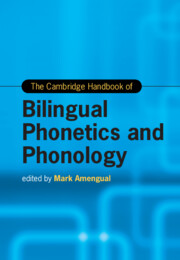Book contents
- The Cambridge Handbook of Bilingual Phonetics and Phonology
- Cambridge Handbooks in Language and Linguistics
- The Cambridge Handbook of Bilingual Phonetics and Phonology
- Copyright page
- Dedication
- Contents
- Figures
- Tables
- Contributors
- Acknowledgments
- Introduction Bilingual Phonetics and Phonology
- Part I Approaches to Bilingual Phonetics and Phonology
- 1 Generative Approaches to Bilingual Phonetics and Phonology
- 2 Usage-Based Approaches to Bilingual Phonetics and Phonology
- 3 Sociolinguistic Approaches to Bilingual Phonetics and Phonology
- 4 Psycholinguistic Approaches to Bilingual Phonetics and Phonology
- 5 Neurolinguistic Approaches to Bilingual Phonetics and Phonology
- 6 Computational Approaches to Bilingual Phonetics and Phonology
- Part II Theoretical Models of Bilingual Phonetics and Phonology
- Part III The Phonetics and Phonology of the Bilingual Child
- Part IV The Phonetics and Phonology of the Bilingual Adult
- Part V The Diversity of Bilingual Speakers
- Part VI Variables and Outcomes of Bilingual Speech
- Index
- References
2 - Usage-Based Approaches to Bilingual Phonetics and Phonology
from Part I - Approaches to Bilingual Phonetics and Phonology
Published online by Cambridge University Press: 14 November 2024
- The Cambridge Handbook of Bilingual Phonetics and Phonology
- Cambridge Handbooks in Language and Linguistics
- The Cambridge Handbook of Bilingual Phonetics and Phonology
- Copyright page
- Dedication
- Contents
- Figures
- Tables
- Contributors
- Acknowledgments
- Introduction Bilingual Phonetics and Phonology
- Part I Approaches to Bilingual Phonetics and Phonology
- 1 Generative Approaches to Bilingual Phonetics and Phonology
- 2 Usage-Based Approaches to Bilingual Phonetics and Phonology
- 3 Sociolinguistic Approaches to Bilingual Phonetics and Phonology
- 4 Psycholinguistic Approaches to Bilingual Phonetics and Phonology
- 5 Neurolinguistic Approaches to Bilingual Phonetics and Phonology
- 6 Computational Approaches to Bilingual Phonetics and Phonology
- Part II Theoretical Models of Bilingual Phonetics and Phonology
- Part III The Phonetics and Phonology of the Bilingual Child
- Part IV The Phonetics and Phonology of the Bilingual Adult
- Part V The Diversity of Bilingual Speakers
- Part VI Variables and Outcomes of Bilingual Speech
- Index
- References
Summary
This chapter introduces chief postulates common to usage-based (UB) approaches to language. The UB approach maintains that speakers’ experiences with language shape how language is stored. Experiences with specific words and word combinations in particular linguistic, discursive, and social contexts accrue in memory and subsequently contribute to patterns of variability evident in speech productions. Usage-based approaches regularly consider independent effects on lexical representations of decontextualized prior probabilities (e.g. phone/word/bigram frequencies, type frequencies), and, increasingly, contextually informed counts (e.g. lexical items’ cumulative exposure to conditioning effects of the production contexts, phone/word probabilities) are considered. This chapter offers an overview of studies exploring the connection between usage patterns and bilingual sound systems as well as studies exploring evidence of interlingual influence arising from bilingual lexical storage (schematic ties in memory). The chapter suggests potential avenues for future UB research into bilingual phonetics and phonology.
Keywords
- Type
- Chapter
- Information
- Publisher: Cambridge University PressPrint publication year: 2024

